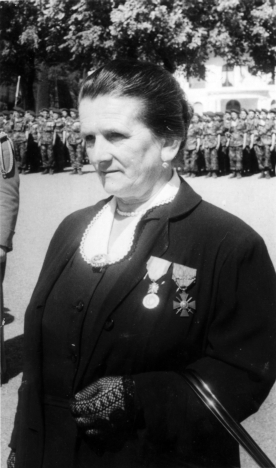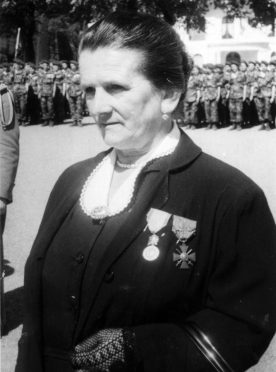Not long ago, we learned about Florentino Goikoetxea, a mugalari – a smuggler – who helped fugitives cross the French-Spanish border during World War II. Of course, he didn’t act alone. Those fugitives needed a place to stay, and sometimes heal, before they could make the crossing. That was the role of people like Kattalin Agirre. She gave the fugitives a temporary home before they made the trek across the Pyrenees with Florentino. Despite numerous accolades for her efforts, it is surprisingly hard to find much about Kattalin’s life.

- Kattalin was born in Sara on August 28, 1897. Her parents were Martin Lamothe and Joséphine Légasse. At a young age — thirteen — Kattalin began working at the Euskalduna Hotel in Ziburu then moved to Paris to work as a maid. In April of 1927, she married Pierre Aguirre and took his surname. Pierre died not long after from the lingering effects of a gas attack in World War I. She moved back to Ziburu and the Euskalduna Hotel, which was run by her cousin Catherine Muruaga. From 1936, she began helping refugees escaping the Spanish Civil War.
- As World War II broke out, Kattalin used her connections amongst the smugglers in the Pyrenees mountains to help people flee the other direction. As part of the Margot network, she sheltered “children” – a code word for fugitives – in her home, beginning with a request by Marguerite Corysande de Grammont to shelter three such “children.” As part of the Comet line, she sheltered downed airmen, nursing them to health until she could get them to Florentino and across the border. She had a small farmhouse in the foothills of the Pyrenees where she would harbor these fugitives.
- At some point, she was caught and sent to a concentration camp. She survived and was freed when the Allies liberated the camp.
- Eventually, her role in the resistance grew beyond sheltering fugitives. She began passing intel to the Nana network, run by the US Office of Strategic Services. Aided by her daughter, 14-year-old Joséphine “Fifine,” she also helped smuggle money and radio equipment across the border.
- For her efforts, she was recognized multiple times by the French government, receiving the Médaille militaire, the Croix de Guerre, and the Legion of Honour.
- Kattalin died in Ziburu on July 22, 1992. On her deathbed she said “I didn’t do any more than I had to do.”
Primary sources: Kattalin Aguirre, Wikipedia; Auñamendi Eusko Entziklopedia. Aguirre, Kattalin. Available at: https://aunamendi.eusko-ikaskuntza.eus/en/aguirre-kattalin/ar-154382/; Freedom Trails: Great Escapes from World War I to the Korean War by Terry C Treadwell
Discover more from Buber's Basque Page
Subscribe to get the latest posts sent to your email.



One thought on “Basque Fact of the Week: Kattalin Agirre, Member of the French Resistance”